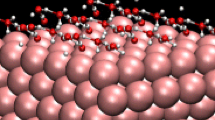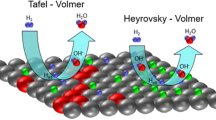Abstract
The cathodic superactivation of gold using a repetitive potential cycling procedure is reported, and its significance for the oxygen evolution reaction is discussed. The superactivated surfaces exhibit a transient oxygen evolution response subsequent to monolayer oxidation and prior to extensive visible oxygen evolution. The kinetics of this oxygen evolution process are studied using a variety of transient and steady-state electrochemical techniques. The Tafel slope is shown to decrease with increased activation of the gold surface from ca. 120 to ca. 48 mV dec−1, and the charge transfer kinetics are enhanced by over three orders of magnitude for the superactivated electrodes. A mechanistic scheme involving the formation of monomeric Au(III) hydroxyl complexes of the form Au(OH)6 3− is proposed. The latter are of a transient nature and may be regarded as intermediates in the early stages of hydrous ß-oxide growth. These labile species may catalyse oxygen evolution by enhancing the formation of peroxy species that subsequently decompose with loss of oxygen gas from the surface oxide. This novel mechanistic route is in excellent agreement with recent literature studies and has the potential to unite a number of strands in the current understanding of the oxygen evolution reaction at gold surfaces.













Similar content being viewed by others
Notes
For a single electron transfer process, the transfer coefficient α can be equated with the symmetry factor β which, in the case of a symmetrical potential energy barrier, is equal to 0.5. For a multi-electron transfer process, the situation is more complicated and α is related to β as follows: \( {a}_f=\frac{n_f}{v}+{n}_r\beta \), where the subscript f denotes the forward reaction, n f is the number of electrons transferred before the rate-determining step (rds), v is the number of occurrences of the rds in the electrode reaction and n r is the number if electrons involved in the rds. However, in terms of a mechanistic analysis, it is useful to view a multistep electrode process as a sequence of one-electron transfer steps and/or chemical steps. Hence, β can be applied to the treatment of each elementary electron transfer step. In practical terms, it should be noted that the experimentally measurable quantity—the Tafel slope b—is related to α as follows: \( b=2.303\left(\frac{RT}{aF}\right) \) [70–74].
References
Schlogl R (2010) ChemSusChem 3:209–222
Whitesides GM, Crabtree GW (2007) Science 315:796–798
Dau H, Limberg C, Reier T, Risch M, Roggan S, Strasser P (2010) ChemCatChem 2:724–761
Chen Z, Higgins D, Yu A, Zhang L, Zhang J (2011) Energy Environ Sci 4:3167–3192
Neburchilov V, Wang H, Martin JJ, Qu W (2010) J Power Sources 195:1271–1291
Cheng F, Chen J (2012) Chem Soc Rev 41:2172–2192
Weber AZ, Mench MM, Meyers JP, Ross PN, Gostick JT, Liu Q (2011) J Appl Electrochem 41:1137–1164
Koper MTM (2008) Faraday Discuss 140:11–24
Koper MTM (2011) J Electroanal Chem 660:254–260
Norskov JK, Rossmeisl J, Logadottir A, Lindqvist L, Kitchin JR, Bligaard T, Jonsson H (2004) J Phys Chem B 108:17886–17892
Rossmeisl J, Logadottir A, Norskov JK (2005) Chem Phys 319:178–184
Rossmeisl J, Qu ZW, Zhu H, Kroes GJ, Norskov JK (2007) J Electroanal Chem 607:83–89
Shen X, Small YA, Wang J, Allen PB, Fernandez-Serra MV, Hybertsen MS, Muckerman JT (2010) J Phys Chem C 114:13695–13704
Suntivich J, May KJ, Gasteiger H, Goodenough JB, Shao-Horn Y (2011) Science 334:1383–1385
Subbaraman R, Tripkovic D, Chang KC, Strmcnik D, Paulikas AP, Hirunsit P, Chan M, Greeley J, Stamenkovic V, Markovic NM (2012) Nat Mater 11:550–557
Busch M, Ahlberg E, Panas I (2011) Phys Chem Chem Phys 13:15062–15068
Su HY, Gorlin Y, Man IC, Calle-Vallejo F, Nørskov JK, Jaramillo TF, Rossmeisl J (2012) Phys Chem Chem Phys 14:14010–14022
Zaharieva I, Chernev P, Risch M, Klingan K, Kohlhoff M, Fischerb A, Dau H (2012) Energy Environ Sci 5:7081–7089
Risch M, Klingan K, Heidkamp J, Ehrenberg D, Chernev P, Zaharieva I, Dau H (2011) Chem Commun 47:11912–11914
Kinoshita K (1992) Electrochemical oxygen technology. Wiley, New York
Schwab GM (1981) In: Anderson JR, Boudart M (ed) Catalysis—science and technology vol. 2. Springer-Verlag, Berlin p.4
Bockris JOM, Reddy AKN, Gamboa-Aldeco M (2000) Modern electrochemistry, vol. 2A, 2nd edn. Kluwer, New York, p 1275
Koper MTM (2009) Faraday Discuss 140:11–24
Burke LD (2004) Gold Bull 37:125–135
Burke LD, O’Connell AM, O’Mullane AP (2003) J Appl Electrochem 33:1125–1135
Burke LD, Kinsella LM, O’Connell AM (2004) Russ J Electrochem 40:1105–1114
Burke LD, Nugent PF (1997) Gold Bull 30:43–53
Burke LD, Nugent PF (1998) Gold Bull 31:39–50
Burke LD, Ahern AJ, O’Mullane AP (2002) Gold Bull 35:3–10
Burke LD, Bruton GM, Collins JA (1998) Electrochim Acta 44:1467–1479
Burke LD, Buckley DT, Morrissey JA (1994) Analyst 119:841–845
Plowman BJ, O’Mullane AP, Bhargava SK (2011) Faraday Discuss 152:43–62
Burke LD, Moran JM, Nugent PF (2003) J Solid State Electrochem 7:529–538
Burke LD, Hurley LM (1999) Electrochim Acta 44:3451–3473
Burke LD, Hurley LM (2002) J Solid State Electrochem 6:101–110
Nowicka AM, Hasse U, Sievers G, Donten M, Stojek Z, Fletcher S, Scholz F (2010) Angew Chem Int Ed 49:3006–3009
Sun K, Kohyama M, Tanaka S, Takeda S (2012) J Phys Chem A 116:9568–9573
Burke LD (1994) Electrochim Acta 39:1841–1848
Burke LD, O’Mullane AP (2000) J Solid State Electrochem 4:285–297
Burke LD, O’Dwyer KJ (1990) Electrochem Acta 35:1821–1827
Burke LD, O’Dwyer KJ (1990) Electrochim Acta 35:1829–1835
O’Mullane AP, Bhargava SK (2011) Electrochem Commun 13:852–855
Cherevko S, Kulyk N, Chung CH (2012) Electrochim Acta 69:190–196
Conway BE (1995) Prog Surf Sci 49:331–452
Laitinen HA, Chao MS (1961) J Electrochem Soc 108:726–731
Nicol M (1980) Gold Bull 13:46–55
Puddephatt R (1978) The chemistry of gold. Elsevier, New York, p 274
Peuckert M, Coenen FP, Bonzel HP (1984) Surf Sci 141:515–532
Ferro CM, Calandra AJ, Arvia AJ (1975) J Electroanal Chem 59:239–253
Martins ME, Cordova R, Arvia AJ (1981) Electrochim Acta 26:1547–1554
Oesch U, Janata J (1983) Electrochim Acta 28:1237–1246
Juodkazis K, Juodkazyte J, Jasulaitiene V, Lukinskas A, Sebeka B (2000) Electrochem Commun 2:503–507
Schneeweiss MA, Kolb DM (1997) Solid State Ionics 94:171–179
Xia SJ, Birss VI (2001) J Electroanal Chem 500:562–573
Diaz-Moralez O, Calle-Vallejo F, de Munck C, Koper MTM (2013) Chem Sci 4:2334–2343
Burke LD, McRann M (1981) J Electroanal Chem 125:387–399
Burke LD, Hopkins GP (1984) J Appl Electrochem 14:679–686
Chialvo AC, Triaca WE, Arvia AJ (1984) J Electroanal Chem 171:303–316
Burke LD, O’Sullivan EJM (1981) J Electroanal Chem 117:155–160
Burke LD, Lyons MEG, Whelan DP (1982) J Electroanal Chem 139:131–142
Burke LD, Lyons MEG (1986) In: White RE, Bockris JOM, Conway BE (ed) Modern aspects of electrochemistry, no. 18. Plenum Press, New York p.169–248
Burke LD, Nugent PF (1998) J Electroanal Chem 444:19–29
Burke LD, Cunnane VJ, Lee BH (1992) J Electrochem Soc 139:399–406
Burke LD, O’Leary WA (1989) J Appl Electrochem 19:758–767
Burke LD, Lee BH, Ryan TG (1990) J Electrochem Soc 137:2417–2422
Selwood PW (1964) Magnetoelectrochemistry, 2nd edn. Interscience, New York, pp 167–341
Harrington DA, van den Driessche P (2011) Electrochim Acta 56:8005–8013
Harrington DA, Conway BE (1987) Electrochim Acta 32:1703–1712
Conway BE (2005) In: Barsoukov E, Macdonald JR (ed) Impedance spectroscopy—theory, experiment, and applications. J. Wiley & Sons, New Jersey p.469–497
Guidelli R, Compton RG, Feliu JM, Gileadi E, Lipkowski J, Schmickler W, Trasatti S (2014) Pure Appl Chem 86:245–258
Guidelli R, Compton RG, Feliu JM, Gileadi E, Lipkowski J, Schmickler W, Trasatti S (2014) Pure Appl Chem 86:259–262
Doyle RL, Godwin IJ, Brandon MP, Lyons MEG (2013) Phys Chem Chem Phys 15:13737–13783
Lyons MEG, Doyle RL, Fernandez D, Godwin IJ, Browne MP, Rovetta A (2014) Electrochem Commun 45:60–62
Lyons MEG, Doyle RL, Fernandez D, Godwin IJ, Browne MP, Rovetta A (2014) Electrochem Commun 45:56–59
Lyons MEG, Brandon MP (2010) J Electroanal Chem 641:119–130
McDonald JJ, Conway BE (1962) Proc Roy Soc London SerA 269:419–440
Meyer RE (1960) J Electrochem Soc 107:847–853
Yeo BS, Klaus SL, Ross PN, Mathies RA, Bell AT (2010) Chem Phys Chem 11:1854–1857
Yeo BS, Bell AT (2012) J Phys Chem C 116:8394–8400
Yeo BS, Bell AT (2011) J Am Chem Soc 133:5587–5593
Acknowledgements
This paper is dedicated to Prof. Stephen Fletcher on the occasion of his 65th birthday. He has truly been an inspiration to physical electrochemists for many years. This publication has emanated in part from research conducted with the financial support of Science Foundation Ireland (SFI) under grant number SFI/10/IN.1/I2969.
Author information
Authors and Affiliations
Corresponding author
Rights and permissions
About this article
Cite this article
Doyle, R.L., Lyons, M.E.G. The mechanism of oxygen evolution at superactivated gold electrodes in aqueous alkaline solution. J Solid State Electrochem 18, 3271–3286 (2014). https://doi.org/10.1007/s10008-014-2665-y
Received:
Revised:
Accepted:
Published:
Issue Date:
DOI: https://doi.org/10.1007/s10008-014-2665-y




